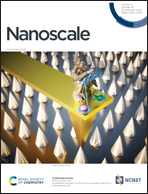Ultra-high rate capability of the synergistically built dual nanostructure of NiCo2S4/nickel foam as an electrode in supercapacitors†
Abstract
The microstructure of electrode materials and its synergism with current collectors have been a research focus in the area of Faraday supercapacitors (FSs), while the microstructure of current collectors has been neglected in most cases. To eliminate the electrochemical bottleneck of FSs, the comprehensive consideration on electrodes should simultaneously include both the microstructures of materials and current collectors, and their synergism. In this work, a dual nanostructure of NiCo2S4/nickel foam is built to achieve an electrode with structure-synergistical contribution from materials and current collectors. The as-built electrode presents an ultra-high rate capacity (1223.8 C g−1 at 2.5 A g−1; 53.40% capacity retention at an ultra-high current density of 148.5 A g−1) and excellent cycling stability (94.56% capacity retention after 10 000 charge–discharge cycles). The as-assembled asymmetrical supercapacitors show both high energy and power densities (76.7 W h kg−1 at 425.7 W kg−1; 41.9 W h kg−1 at 10 643.3 W kg−1). These results demonstrate that the dual nanostructure of the electrode is valuable for achieving high performance supercapacitors.

- This article is part of the themed collection: 2020 Nanoscale HOT Article Collection


 Please wait while we load your content...
Please wait while we load your content...